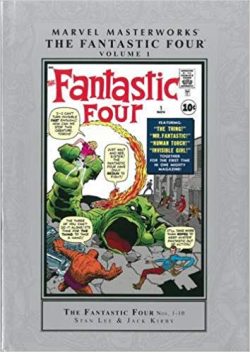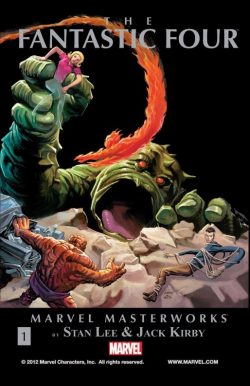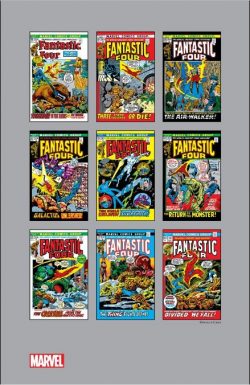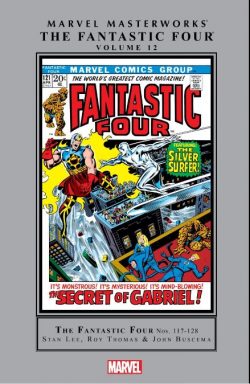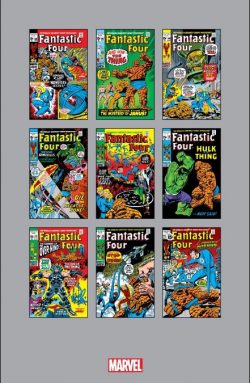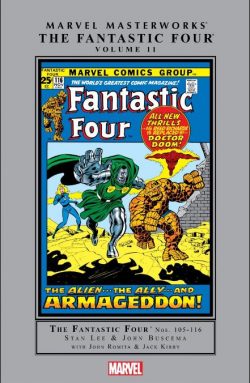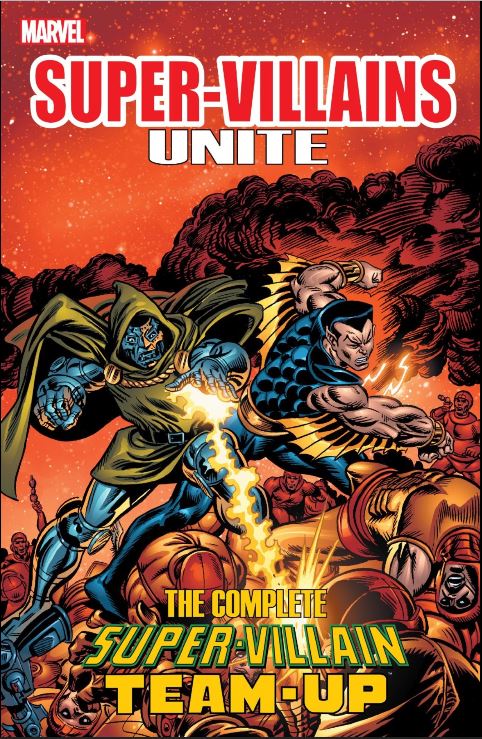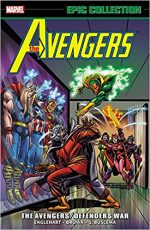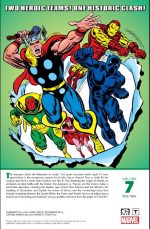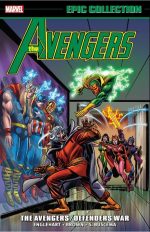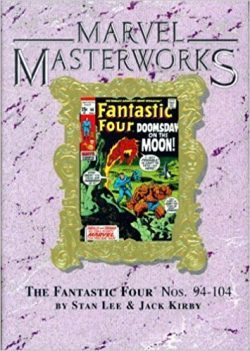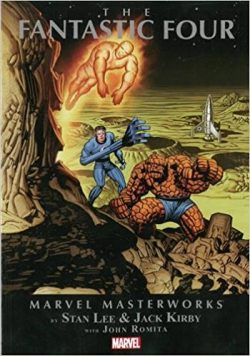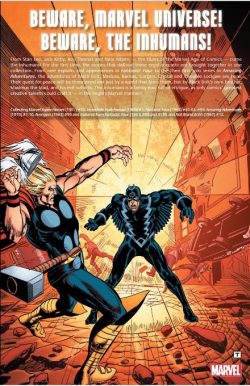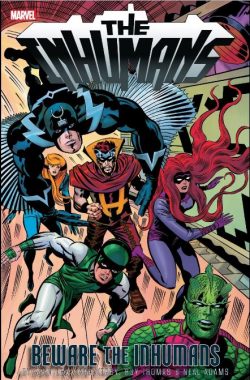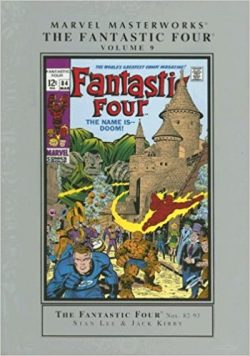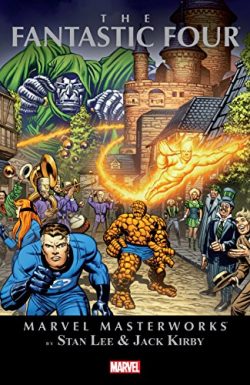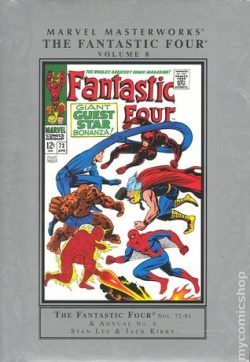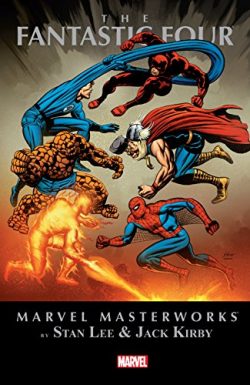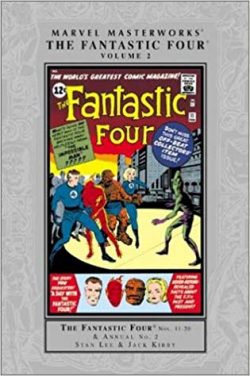
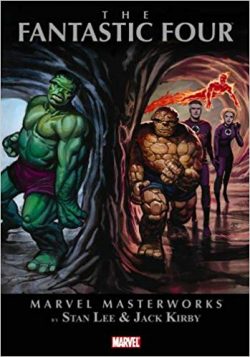
By Stan Lee, Jack Kirby & various (Marvel)
ISBN: 978-0-7851-0980-8 (HB)Â Â Â Â Â Â Â Â Â Â Â Â Â Â Â Â Â Â Â 978-0-7851-3712-2 (TPB)
Fantastic Four #1 is the third most important American comicbook in the industry’s astounding history. Just ahead of it are The Brave and the Bold #28, which brought superhero teams back via the creation of the Justice League of America, and at the top Showcase #4, which introduced the Flash and therefore the Silver Age. Feel free to disagree…
After a troubled period at DC Comics – National Periodicals as it then was – and a creatively productive but disheartening time on the poisoned chalice of the Sky Masters newspaper strip (see Complete Sky Masters of the Space Force), Jack Kirby settled into his job at the small outfit that used to be the publishing powerhouse Timely/Atlas.
He churned out mystery, monster, romance and western material in a market he suspected to be ultimately doomed but, as always, did the best job possible. That quirky genre fare is now considered some of the best of its kind ever seen.
However, his fertile imagination couldn’t be suppressed for long and when the JLA caught the readership’s attention it gave him and writer/editor Stan Lee an opportunity to change the industry forever.
Depending upon who you believe, a golfing afternoon led publisher/owner Martin Goodman ordering his nephew Stan to try a series about a group of super-characters like the one DC was doing. The resulting team quickly took fans by storm. It wasn’t the powers: they’d all been seen since the beginning of the medium. It wasn’t the costumes: they didn’t have any until the third issue.
It was Kirby’s compelling art and the fact that these characters weren’t anodyne cardboard cut-outs. In a real and a recognizable location – New York City – imperfect, raw-nerved, touchy people banded together out of tragedy, disaster and necessity to face the incredible.
In many ways, The Challengers of the Unknown (Kirby’s prototype partners-in-peril at National/DC) laid all the groundwork for the wonders to come, but the staid, almost hide-bound editorial strictures of National would never have allowed the undiluted energy of the concept to run all-but-unregulated.
Fantastic Four #1 (bi-monthly and cover-dated November 1961, by Lee, Kirby, George Klein & Christopher Rule) is crude: rough, passionate and uncontrolled excitement. Thrill-hungry kids pounced on it.
As seen in that ground-breaking premier issue, maverick scientist Reed Richards, his fiancé Sue Storm, their close friend Ben Grimm and Sue’s teenaged brother survived an ill-starred private space-shot after Cosmic rays penetrated their ship’s inadequate shielding and mutated them all.
Richards’ body became elastic, Sue gained the power to turn invisible, Johnny Storm could turn into living flame and poor, tragic Ben devolved into a shambling, rocky freak. Despite these terrifying transformations, before long the quartet had become the darlings of the modern age: celebrity stalwarts alternately saving the world and publicly squabbling shamefully…
This full-colour hardcover or paperback compendium (also available in various digital formats) collects Fantastic Four #11-20, plus the first Annual, and chronologically spans February to November 1963.
We open sans preamble with more groundbreaking innovations as FF #11 offers two short stories instead of the usual book-length yarn. ‘A Visit with the Fantastic Four’ provides a behind-the-scenes travelogue and examination of our stars’ pre-superhero lives, after which ‘The Impossible Man’, proves to be a baddie-free, compellingly comedic tale about facing an unbeatable foe.
The unorthodox shenanigans are rounded off with a suitably grandiose pin-up of Prince Namor the Sub-Mariner.
FF #12 featured an early example of guest-star promotion as the team are required to help the US army capture ‘The Incredible Hulk’: a tale packed with intrigue, action and bitter irony. It’s followed by an even more momentous and game-changing episode.
‘Versus the Red Ghost and his Incredible Super Apes!’ is a cold war thriller pitting the heroic family against a Soviet scientist in the race to reach the Moon: a tale notable both for the moody Steve Ditko inking (replacing adroit Dick Ayers for one glorious month) of Kirby’s artwork and the introduction of the oxygen-rich “Blue Area of the Moon†and the omnipotent, omnipresent cosmic voyeurs called The Watchers…
As the triumphant Americans rocket home, issue #14 touts the return of ‘The Sub-Mariner and the Merciless Puppet Master!’ – with one vengeful fiend made the unwitting mind-slave of the other – and adding lustre and tantalising moral ambivalence to the mighty Sea King who was to become the company’s other all-conquering antihero in months to come…
This epic was followed in turn by ‘The Mad Thinker and his Awesome Android!’ wherein a chilling war of intellects between driven super-scientists resulted in a cerebral yet all-action clash with plenty of room for smart laughs to leaven the drama. The pin-up extra this time is a candid group-shot of the entire team.
Fantastic Four #16 explored ‘The Micro-World of Doctor Doom!’ in a spectacular romp guest-starring new hero Ant-Man whilst also offering a Fantastic Four Feature Page outlining the powers and capabilities of the elastic Mister Fantastic. Despite his resounding defeat, the steel-shod villain promptly returned with more infallible, deadly traps a month later in ‘Defeated by Doctor Doom!’ Except they actually weren’t and soon sent the sinister tyrant packing…
The shape-shifting aliens who challenged the team in their second adventure returned with a new tactic in #18 as the team tackle an implacable foe equipped with their own powers in ‘A Skrull Walks Among Us!’: a potent prelude to greater, cosmos-spanning sagas still to come…
Cover-dated October 1963, Fantastic Four #19 introduced another remarkable, top-ranking super-villain as the quarrelsome quartet travel back to ancient Egypt and become ‘Prisoners of the Pharaoh!’
This time twisting tale tale has been revisited by so many writers that it’s considered one of the key stories in Marvel Universe history: introducing a future-Earth tyrant who would evolve into overarching menace Kang the Conqueror.
Another universe-rending foe debuted and was defeated by brains not brawn in FF #20 as ‘The Mysterious Molecule Man!’ briefly menaced New York before being soundly outsmarted.
The vintage wonderment concludes here with the contents of the first summer Fantastic Four Annual: a spectacular 37-page epic by Lee, Kirby & Ayers as, finally reunited with their wandering prince, the armies of Atlantis invade New York City and the rest of the world in ‘The Sub-Mariner versus the Human Race!’
A monumental tale by the standards of the time (and still today), the saga saw the FF repel the initially overwhelming undersea invasion through valiant struggle, brilliant strategy and technological innovation, as well as providing a secret history of the secretive race Homo Mermanus.
Nothing was really settled except a return to the original status quo, but the thrills are intense and unforgettable…
Also included herein are rousing pin-ups and fact file features. Interspersed by ‘A Gallery of the Fantastic Four’s Most Famous Foes!’ (powerful pin-ups of The Mole Man, Skrulls, Miracle Man, Prince Namor, Doctor Doom, Kurrgo, Master of Planet X, Puppet Master, Impossible Man, The Hulk, Red Ghost and his Indescribable Super-Apes and The Mad Thinker and his Awesome Android), you can enjoy ‘Questions and Answers about the Fantastic Four’; a diagrammatic trip ‘Inside the Baxter Building’ and a bemusing short tale ‘The Fabulous Fantastic Four meet Spider-Man!’.
This is an extended re-interpretation of the first meeting between the two most popular Marvel brands from the premiere issue of the wallcrawler’s own comic. Pencilled this time by Kirby, the dramatic duel was graced by Steve Ditko’s inking which created a truly novel and compelling look.
Some might argue that these yarns might be a little dated in tone, but they these are still classics of comic story-telling illustrated by one of the world’s greatest talents approaching his mature peak. Fast, frantic fun and a joy to read or re-read, this comprehensive, joyous introduction (or even reintroduction) to these characters is a wonderful reminder of just how good comic books can and should be.
© 1963, 2014 Marvel Characters, Inc. All rights reserved.

